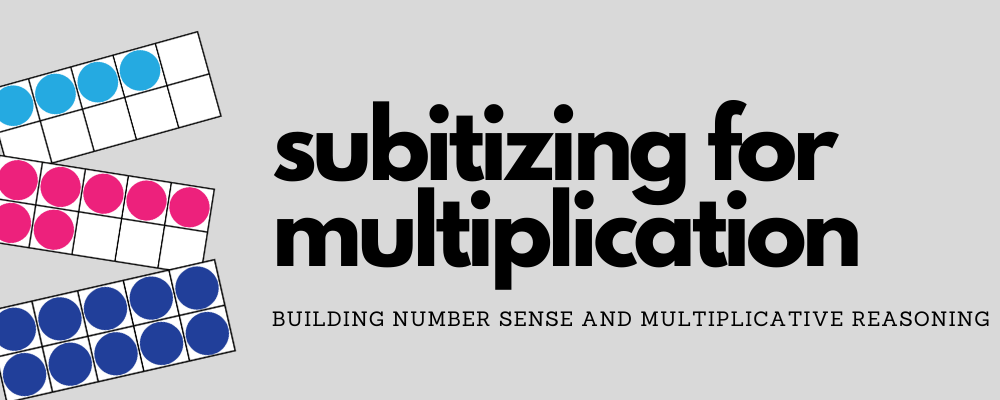
DOWNLOAD THE SUBITIZING CARDS USED IN THIS VIDEO HERE.
It’s the time of the year when many of you are beginning multiplication or starting to think about how you will approach it in your classroom.
We know the importance of subitizing in the the early elementary grades, but today I want to talk about how we can use subitizing in 3rd to 5th grade to help our students develop number sense around multiplication.
The important piece that is often missed when it comes to subitizing is making connections. Making connections is an essential component of fact fluency because it helps our students see how facts relate to each other. This is what SO many students are missing.
Think of that student who knows that 5×5 is 25, but gets stuck when faced with 6×5. That student has not made the connection that 6×5 is just one group of 5 more than 5×5. We need to support students with visual representations to help them make those connections. We know that students move from concrete to representational to abstract, so when we simply begin making connections with numbers on paper, we are doing our students a disservice.
Let’s take a look at how we can take subitizing to another level to begin developing multiplicative reasoning. This will be done with “quick looks” where we show a card to our students for about 2 seconds. During that time, they will try to figure out how many dots are on the cards. The short time frame ensures that they do not have time to count, and will have to rely on knowledge about patterns and grouping.
The dot patterns shown below can all be downloaded for free HERE. to use in your classroom.
Start by showing the dot pattern below. Ask your students to tell you how many they see.
Because they are familiar with dice patterns, they’ll recognize it as 4.
Sometimes when we subitize with kids, we move on to a whole new representation at this point. However this place right here is an essential place to make connections.
Now we’ll show another card.
This time we see 8. Here’s a great opportunity to begin building multiplicative reasoning with kids. When you ask them how they knew there were 8 dots, you’ll probably hear things like, “I know that 4+4=8,” or “I doubled 4 to make 8,” or “I know that 2 groups of 4 = 8.” Even if you have not started formal multiplication with your students, you are helping them build a sense of multiplicative reasoning when they see groups.
Now we’ll show a third card.
This time we see 16 dots. When we ask our students how they know, what will they say? We can expect thoughts like this:
“I know that the number of dots doubled, so I doubled 8 to make 16.”
“I counted 4, 8, 12, 16.”
“I knew that 2 groups of 4 made 8 and then I added on 4 more to make 12, and then 4 more to make 16.”
Do you see how valuable this is? These are skills that are very hard to teach with a pencil and paper, but when we can help students see the connections, it can be powerful! I cannot emphasize the value of connections enough.
Let’s take a look at how we might make connections with another set of cards. This is the sequence that we will use to help students realize that they can use what they know about groups of 5.
THIRD CARD (How can we connect this new representation to the one we just saw?):
FOURTH CARD (How can we connect this new representation to the previous ones?):
 By moving from 1 group of 5 to 2 groups of 5 to 4 groups of 5 to 6 groups of 5, we are helping them make connections like the following:
By moving from 1 group of 5 to 2 groups of 5 to 4 groups of 5 to 6 groups of 5, we are helping them make connections like the following:
“I know that 2 groups of 5 makes 10, and 4 groups of 5 is double that amount.”
“I know that 6 groups of 5 is the same as 4 groups of 5 plus 2 more groups of 5.”
“We saw 2 groups of 5 on the second card, and 4 groups of 5 on the third card, so I just added those up.”
So powerful!
I hope this has helped you understand how easy making connections can be in the classroom. I challenge you take 5 minutes today or tomorrow to do this with your class.
If they are not familiar with sharing strategies, be patient, because you may have to model the strategies that are possible.
If you’d like to try the exact subitizing sequence that I’ve just shown you, you can grab the subitizing cards for free HERE.
Want even more subitizing cards for multiplication? See them HERE. This set includes four different styles – ten frames, dots inside ten frames, rekenreks, and dice patterns. These are ideal for number talks and number strings.












